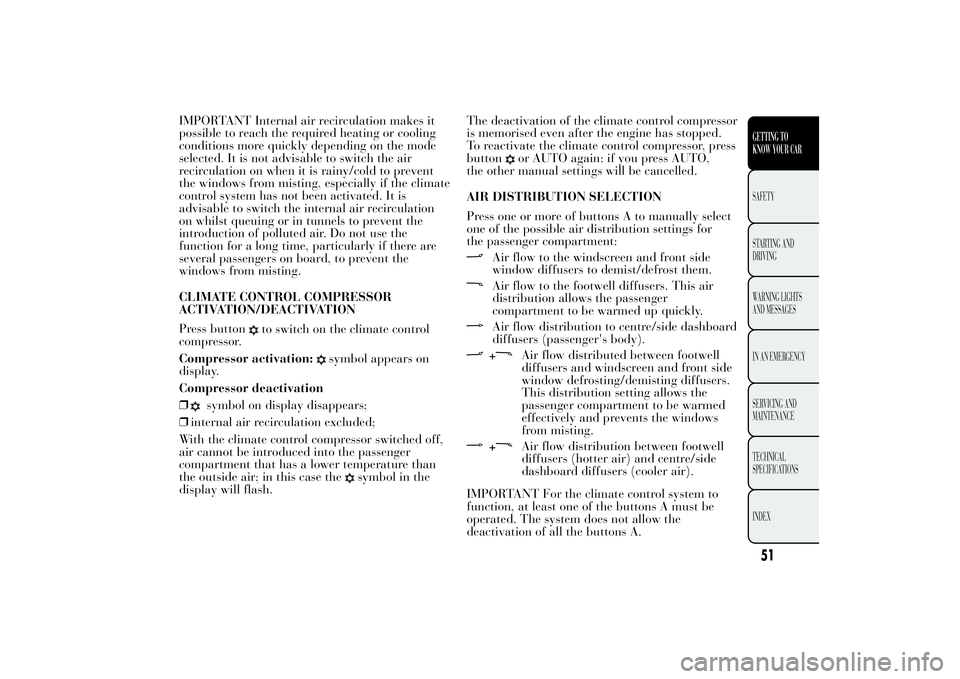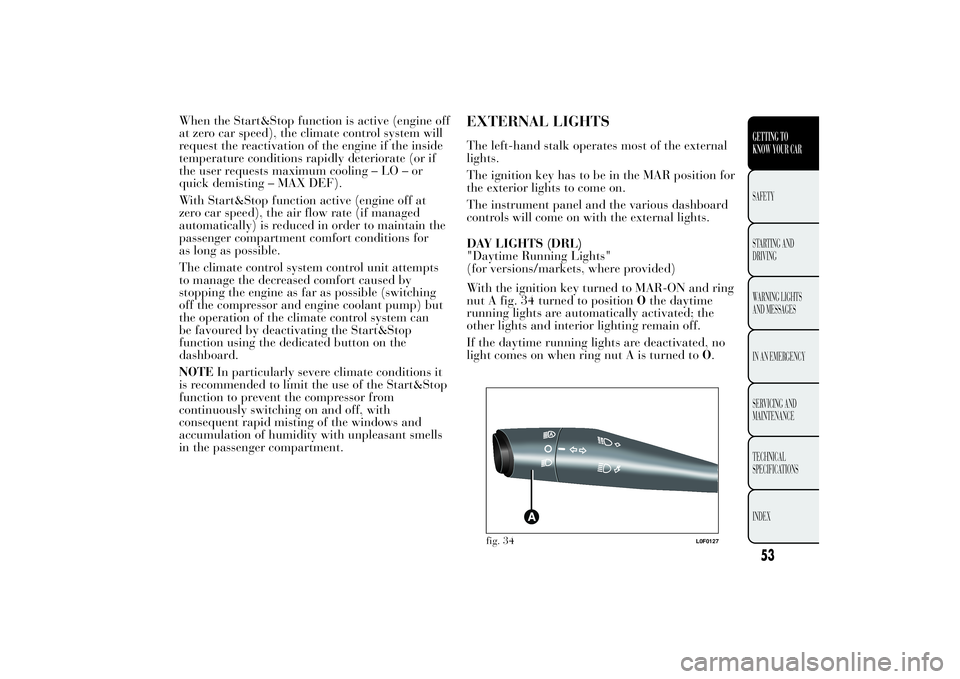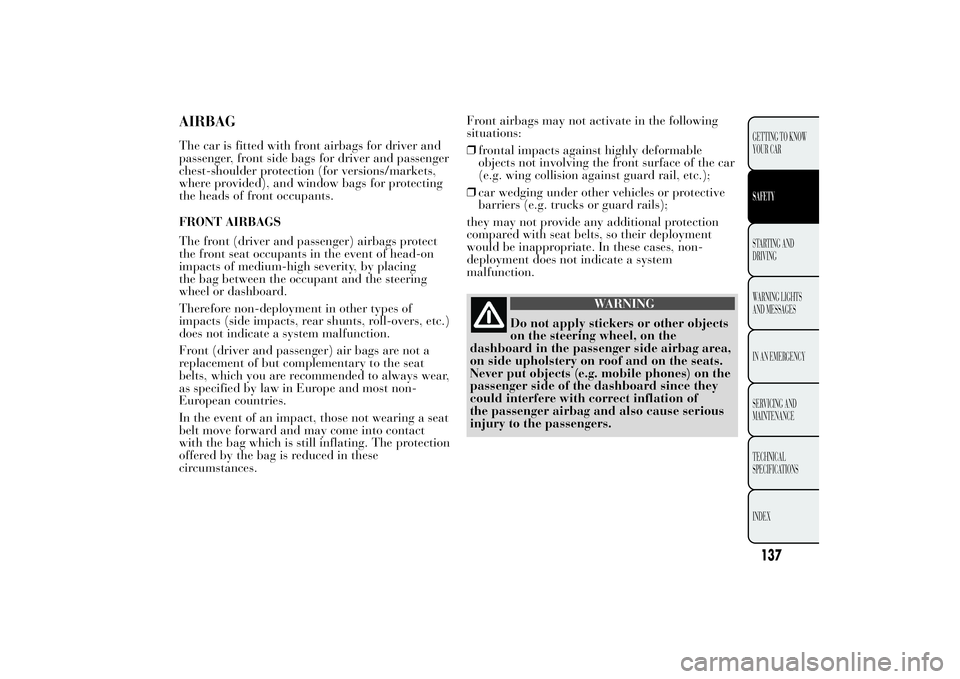window Lancia Ypsilon 2012 Owner handbook (in English)
[x] Cancel search | Manufacturer: LANCIA, Model Year: 2012, Model line: Ypsilon, Model: Lancia Ypsilon 2012Pages: 307, PDF Size: 13.3 MB
Page 53 of 307

IMPORTANT Internal air recirculation makes it
possible to reach the required heating or cooling
conditions more quickly depending on the mode
selected. It is not advisable to switch the air
recirculation on when it is rainy/cold to prevent
the windows from misting, especially if the climate
control system has not been activated. It is
advisable to switch the internal air recirculation
on whilst queuing or in tunnels to prevent the
introduction of polluted air. Do not use the
function for a long time, particularly if there are
several passengers on board, to prevent the
windows from misting.
CLIMATE CONTROL COMPRESSOR
ACTIVATION/DEACTIVATION
Press button
to switch on the climate control
compressor.
Compressor activation:
symbol appears on
display.
Compressor deactivation
❒
symbol on display disappears;
❒internal air recirculation excluded;
With the climate control compressor switched off,
air cannot be introduced into the passenger
compartment that has a lower temperature than
the outside air; in this case the
symbol in the
display will flash.The deactivation of the climate control compressor
is memorised even after the engine has stopped.
To reactivate the climate control compressor, press
button
or AUTO again: if you press AUTO,
the other manual settings will be cancelled.
AIR DISTRIBUTION SELECTION
Press one or more of buttons A to manually select
one of the possible air distribution settings for
the passenger compartment:
Air flow to the windscreen and front side
window diffusers to demist/defrost them.Air flow to the footwell diffusers. This air
distribution allows the passenger
compartment to be warmed up quickly.Air flow distribution to centre/side dashboard
diffusers (passenger's body).+
Air flow distributed between footwell
diffusers and windscreen and front side
window defrosting/demisting diffusers.
This distribution setting allows the
passenger compartment to be warmed
effectively and prevents the windows
from misting.
+
Air flow distribution between footwell
diffusers (hotter air) and centre/side
dashboard diffusers (cooler air).
IMPORTANT For the climate control system to
function, at least one of the buttons A must be
operated. The system does not allow the
deactivation of all the buttons A.
51GETTING TO
KNOW YOUR CARSAFETY
STARTING AND
DRIVING
WARNING LIGHTS
AND MESSAGES
IN AN EMERGENCY
SERVICING AND
MAINTENANCE
TECHNICAL
SPECIFICATIONS
INDEX
Page 55 of 307

When the Start&Stop function is active (engine off
at zero car speed), the climate control system will
request the reactivation of the engine if the inside
temperature conditions rapidly deteriorate (or if
the user requests maximum cooling – LO – or
quick demisting – MAX DEF).
With Start&Stop function active (engine off at
zero car speed), the air flow rate (if managed
automatically) is reduced in order to maintain the
passenger compartment comfort conditions for
as long as possible.
The climate control system control unit attempts
to manage the decreased comfort caused by
stopping the engine as far as possible (switching
off the compressor and engine coolant pump) but
the operation of the climate control system can
be favoured by deactivating the Start&Stop
function using the dedicated button on the
dashboard.
NOTEIn particularly severe climate conditions it
is recommended to limit the use of the Start&Stop
function to prevent the compressor from
continuously switching on and off, with
consequent rapid misting of the windows and
accumulation of humidity with unpleasant smells
in the passenger compartment.
EXTERNAL LIGHTSThe left-hand stalk operates most of the external
lights.
The ignition key has to be in the MAR position for
the exterior lights to come on.
The instrument panel and the various dashboard
controls will come on with the external lights.
DAY LIGHTS (DRL)
"Daytime Running Lights"
(for versions/markets, where provided)
With the ignition key turned to MAR-ON and ring
nut A fig. 34 turned to positionOthe daytime
running lights are automatically activated; the
other lights and interior lighting remain off.
If the daytime running lights are deactivated, no
light comes on when ring nut A is turned toO.
fig. 34
L0F0127
53GETTING TO
KNOW YOUR CARSAFETY
STARTING AND
DRIVING
WARNING LIGHTS
AND MESSAGES
IN AN EMERGENCY
SERVICING AND
MAINTENANCE
TECHNICAL
SPECIFICATIONS
INDEX
Page 59 of 307

WINDOW CLEANINGThe right stalk controls windscreen wiper/washer
and heated rear window wiper/washer operation.
WINDSCREEN WASHER/WIPER
They can be operated only with the ignition key
turned to MAR.
The ring nut A fig. 35 can be moved to four
different positions:
windscreen wiper off.intermittent operation.
AUTO
rain sensor activation (for versions/markets,
where provided) (the windscreen wipers
adapt the operating speed automatically to
suit the intensity of the rain)continuous slow operation.continuous fast operation.Move the stalk upwards (unstable position) to
limit operation to the time for which the stalk is
held in this position. When released, the stalk will
return to its default position and the wiper will
be automatically stopped.
With the ring nut A fig. 35 in position
, the
windscreen wiper will automatically adapt
operating speed to the speed of the car.
With the windscreen wipers operational, if reverse
gear is engaged, the rear window wiper is
automatically activated.
Never use the windscreen wipers to
remove layers of snow or ice from the
windscreen. In such conditions, the
windscreen wipers may be subjected to
excessive stress and the motor protection,
which prevents operation for a few seconds,
may intervene. If operation is not restored
(even after using the key to restart the engine),
contact a Lancia Dealership.Do not operate the windscreen wiper
with the blades lifted from the
windscreen.
fig. 35
L0F0126
57GETTING TO
KNOW YOUR CARSAFETY
STARTING AND
DRIVING
WARNING LIGHTS
AND MESSAGES
IN AN EMERGENCY
SERVICING AND
MAINTENANCE
TECHNICAL
SPECIFICATIONS
INDEX
Page 61 of 307

Deactivation
If the engine is stopped with ring nut A in
"automatic" position (AUTO), no wiping cycle is
performed when it is next started even if rain is
present. This prevents accidental activation of the
rain sensor when the engine is started (e.g. when
the windscreen is being washed by hand or the
wipers are stuck to the windscreen by ice).
To restore automatic operation of the rain sensor,
turn ring nut A from "automatic" position
(AUTO) toOposition and then turn the ring nut
back to the AUTO position.
When the rain sensor is reactivated using any of
the manoeuvres described above, reactivation
is indicated by a single stroke of the windscreen
wipers, regardless of the condition of the
windscreen. If the sensitivity is changed whilst the
rain sensor is operating, a windscreen wiper stroke
is carried out to confirm the change.
In the event of malfunction of the rain sensor
whilst it is active, the windscreen wiper operates
intermittently at a speed consistent with the
sensitivity setting of the rain sensor, regardless of
whether there is rain on the glass (on some
versions sensor failure is indicated on the display).
The sensor continues to operate and it is possible
to set the windscreen wiper to continuous mode
(1
stor 2
nd
speed). The failure indication remains
for as long as the sensor is active.
The rain sensor is able to recognise, and
automatically adjust itself in the presence of the
following conditions:❒presence of dirt on the controlled surface (salt,
dirt, etc.);
❒presence of streaks of water caused by the worn
window wiper blades;
❒difference between day and night.
Do not activate the rain sensor when
washing the car in an automatic car
wash.Make sure the device is switched off if
there is ice on the windscreen.
WARNING
Make sure the device is switched off
whenever the windscreen must be
cleaned.
59GETTING TO
KNOW YOUR CARSAFETY
STARTING AND
DRIVING
WARNING LIGHTS
AND MESSAGES
IN AN EMERGENCY
SERVICING AND
MAINTENANCE
TECHNICAL
SPECIFICATIONS
INDEX
Page 62 of 307

REAR WINDOW WASHER/ WIPER
It can be operated only with the ignition key
turned to MAR.
Activation
Turn the ring nut B fig. 3 5 from
to
to operate
the rear window wiper as follows:
❒in intermittent mode when the windscreen wiper
is not operating;
❒in synchronous mode (at half the speed of the
windscreen wiper) when the windscreen wiper
is operating;
❒in continuous mode with reverse gear engaged
and the control active.
With the windscreen wiper on and reverse gear
engaged, rear window wiping will be continuous.
Pushing the stalk towards the dashboard
(unstable position) the rear window washer jet
will activate. Keep the stalk pushed for more than
half a second to activate the rear window wiper
as well. Releasing the stalk will activate the smart
washing function, as described for the windscreen
wiper.
Deactivation
The function stops when the stalk is released.
Do not use the rear window wiper to
remove layers of snow or ice. In these
conditions, the windscreen wipers may
be submitted to excessive effort resulting in
the motor protection cutting in and wiper
operation being inhibited for a few seconds. If
operation is not restored, contact a Lancia
Dealership.
60GETTING TO
KNOW YOUR CAR
SAFETY
STARTING AND
DRIVING
WARNING LIGHTS
AND MESSAGES
IN AN EMERGENCY
SERVICING AND
MAINTENANCE
TECHNICAL
SPECIFICATIONS
INDEX
Page 80 of 307

ELECTRIC WINDOWSThese operate when the ignition key is turned to
MAR and for about three minutes after turning
the key to STOP or removing it if one of the front
doors is open.
The control buttons are located in the door panels
(for versions/markets, where provided) (the driver
side door panel can be used to operate all the
windows).
An anti-crush device operates when the front and
rear windows are raised (for versions/markets,
where provided).
WARNING
Improper use of the electric windows
can be dangerous. Before and during
operation, always check that passengers are
not exposed to the risk of being injured
either directly by the moving windows or
through objects getting caught or struck by
them. When leaving the car, always remove
the ignition key to avoid the risk of injury
of people still on board due to accidental
operation of the electric windows.CONTROLS
Driver side front door
A fig. 57: opening/closing front left window;
"continuous automatic" operation during window
opening/closing stage;
B: opening/closing front right window;
"continuous automatic" operation during window
opening/closing stage (for versions/markets,
where provided);
C: enabling/disabling of rear door electric window
controls
D: opening/closing rear left window (for
versions/markets, where provided); "continuous
automatic" operation during window opening/
closing stage
fig. 57
L0F0162
78GETTING TO
KNOW YOUR CAR
SAFETY
STARTING AND
DRIVING
WARNING LIGHTS
AND MESSAGES
IN AN EMERGENCY
SERVICING AND
MAINTENANCE
TECHNICAL
SPECIFICATIONS
INDEX
Page 81 of 307

E: opening/closing rear right window (for
versions/markets, where provided); "continuous
automatic" operation during window opening/
closing stage.
Push the buttons to open/close the desired
window. When one of the two buttons is pressed
briefly, the window moves in stages; if the button
is held down, "continuous automatic" operation
is activated both for closing and opening.
If the control button is pressed again, the window
will stop in the desired position. If the button is
held down for several seconds, the window raises
or lowers automatically (only with ignition key
in MAR position).
Front and rear passenger doors
(for versions/markets, where provided)
On the passenger side front door control panel,
and on some versions also on the rear doors,
buttons are provided to control the associated
windows.
Anti-crush safety device
The car is equipped with an anti-crush function
for the raising of the front and rear windows. This
safety system detects the presence of an obstacle
during the window closing travel and intervenes
by stopping and reversing the window travel,
depending on its position.
This device is also useful if the windows are
activated accidentally by children on board the
car.The anti-crush safety function is active both
during the manual and the automatic operation of
the window. When the anti-crush system is
activated the window travel is immediately
interrupted and then reversed. The window
cannot be operated in any way during this
operation.
IMPORTANT If the anti-crush protection
intervenes 3 consecutive times within 1 minute or
is faulty, the automatic closing operation of the
window is inhibited, only allowing it in steps
of half a second; the button is released for the
subsequent manoeuvre. In order to restore the
correct operation of the system, the relevant
window must be lowered.
IMPORTANT With ignition key at STOP or
removed, the electric windows remain active for
about 3 minutes and are deactivated when a door
is opened.
IMPORTANT Where the anti-crush function is
present, pressing button
on the remote control
for more than 2 seconds opens the windows for as
long as the button is pressed. Pressing the
button for more than 2 seconds closes the
windows.
The system conforms to the 2000/4/EC
standard concerning the safety of
passengers leaning out of the passenger
compartment.
79GETTING TO
KNOW YOUR CARSAFETY
STARTING AND
DRIVING
WARNING LIGHTS
AND MESSAGES
IN AN EMERGENCY
SERVICING AND
MAINTENANCE
TECHNICAL
SPECIFICATIONS
INDEX
Page 82 of 307

Electric window system initialisation
The initialisation procedure must be carried out
with the doors closed and for each door, as
described below:
❒fully close the window to initialise manually;
❒after the window has reached the upper end of
travel, hold down the closing control for at
least 1 second.
LUGGAGE COMPARTMENTThe luggage compartment unlocking is electrically
operated and is deactivated when the car is in
motion.
OPENING
When unlocked, the luggage compartment can be
opened from outside the car using the power
handle A fig. 58 located under the tailgate edge
until the unlocking click is heard or pressing
the
button on the remote control.
The direction indicators will blink twice and an
internal light will switch on when the luggage
compartment is opened: the light switches off
automatically when the luggage compartment is
closed. The light switches off automatically after a
few minutes if the tailgate is left open.
fig. 58
L0F0031
80GETTING TO
KNOW YOUR CAR
SAFETY
STARTING AND
DRIVING
WARNING LIGHTS
AND MESSAGES
IN AN EMERGENCY
SERVICING AND
MAINTENANCE
TECHNICAL
SPECIFICATIONS
INDEX
Page 96 of 307

The LED above the
button is on when the
system is deactivated.
ENGINE STOPPING FAILURE CONDITIONS
When the system is active, due to comfort,
emission control and safety reasons, the engine
does not stop in some conditions, among which:
❒engine still cold;
❒especially cold outside temperature;
❒battery not sufficiently charged;
❒heated rear window activated;
❒windscreen wipers working at maximum speed;
❒particulate filter regeneration (DPF) in progress
(diesel engines only);
❒driver's door not shut;
❒driver's seat belt not fastened;
❒reverse gear engaged (for example, for parking
manoeuvres);
❒for versions equipped with automatic climate
control (for versions/markets, where provided),
if an adequate level of thermal comfort has
not been reached or with MAX-DEF activation;
❒during the first period of use, to initialise the
system.
If climate comfort is to be favoured, the
Start&Stop system can be disabled,
for a continuous operation of the
climate control system.ENGINE RESTARTING CONDITIONS
For reasons of comfort, to limit harmful emissions
and for safety purposes, the engine can restart
automatically without any action by the driver if
certain conditions are met, including:
❒battery not sufficiently charged;
❒windscreen wipers working at maximum speed;
❒reduced braking system vacuum (e.g. if the
brake pedal is pressed repeatedly);
❒car moving (e.g. when driving on roads with a
gradient);
❒engine stopping by Start&Stop system for over
3 minutes;
❒for versions equipped with automatic climate
control (for versions/markets where provided),
to enable suitable thermal comfort or with
MAX-DEF activation.
With gear engaged, automatic engine restarting is
possible only by fully depressing the clutch pedal.
The driver is informed by the displaying of a
message on the display and - for versions/markets,
where provided - by the flashing of the symbol
.
94GETTING TO
KNOW YOUR CAR
SAFETY
STARTING AND
DRIVING
WARNING LIGHTS
AND MESSAGES
IN AN EMERGENCY
SERVICING AND
MAINTENANCE
TECHNICAL
SPECIFICATIONS
INDEX
Page 139 of 307

AIRBAGThe car is fitted with front airbags for driver and
passenger, front side bags for driver and passenger
chest-shoulder protection (for versions/markets,
where provided), and window bags for protecting
the heads of front occupants.
FRONT AIRBAGS
The front (driver and passenger) airbags protect
the front seat occupants in the event of head-on
impacts of medium-high severity, by placing
the bag between the occupant and the steering
wheel or dashboard.
Therefore non-deployment in other types of
impacts (side impacts, rear shunts, roll-overs, etc.)
does not indicate a system malfunction.
Front (driver and passenger) air bags are not a
replacement of but complementary to the seat
belts, which you are recommended to always wear,
as specified by law in Europe and most non-
European countries.
In the event of an impact, those not wearing a seat
belt move forward and may come into contact
with the bag which is still inflating. The protection
offered by the bag is reduced in these
circumstances.Front airbags may not activate in the following
situations:
❒frontal impacts against highly deformable
objects not involving the front surface of the car
(e.g. wing collision against guard rail, etc.);
❒car wedging under other vehicles or protective
barriers (e.g. trucks or guard rails);
they may not provide any additional protection
compared with seat belts, so their deployment
would be inappropriate. In these cases, non-
deployment does not indicate a system
malfunction.
WARNING
Do not apply stickers or other objects
on the steering wheel, on the
dashboard in the passenger side airbag area,
on side upholstery on roof and on the seats.
Never put objects (e.g. mobile phones) on the
passenger side of the dashboard since they
could interfere with correct inflation of
the passenger airbag and also cause serious
injury to the passengers.
137GETTING TO KNOW
YOUR CARSAFETYSTARTING AND
DRIVING
WARNING LIGHTS
AND MESSAGES
IN AN EMERGENCY
SERVICING AND
MAINTENANCE
TECHNICAL
SPECIFICATIONS
INDEX